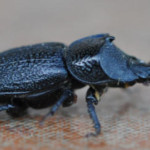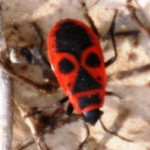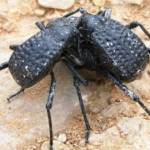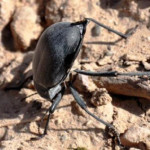This Rugose Stag Beetle is actually a tiny little fellow despite his rhinoceros like appearance. The odd face mask staring at you is one of a group of beetles called Fire Bugs.
What do rock music and the insect world have in common? Superstars, that’s what. Here’s an easy question for you: What was the most popular rock group in history? The Beatles, of course. Now make this arthropodic leap of irony and answer this: What it the most successful group of insects in the world? Beetles, of course. The Coleoptera are in fact the largest single order or animals in the world. Much more popular than that harmonious bunch of homo sapiens with the odd spelling.
The more odoriferous side of beetles are seen here as a pair of Dung Beetles wrestle for a bit of you know what. The guy on the right standing on his head and exposing his rear end is a Darkling Beetle. Get too close to that glistening wet spot and you’ll choke like you’ve been exposed to tear gas.
Now you can argue whether or not John, Paul, Ringo, and George deserve the title or how they got it to begin with, but there is no zoological doubt in the world that beetles rule. One out of every four species in the animal kingdom is a beetle; about 350,000 different kinds and counting; over 30,000 in North America. They are among the smallest, largest, fastest, strongest, and most colorful members of the insect community. There may very well be an unnamed new member of the beetle clan in your own backyard. Get out there and look! Current theory holds that modern beetles evolved sometime during the Jurrasic period along with dinosaurs but their earliest ancestors started crawling around the earth some 265 million years ago during the Permian Period. Despite all the earthly upheaval since then Coleopterans have seen the dinosaurs and a lot of other animals come and go – yet they’re still here thriving with incredible success. Why? Let us consider a few answers to this very important question.
- First off, there is the whole insect design thing. External armor, small size, exceptional birth rate, ability to eat nearly anything, and to survive climatic extremes. That alone means you have a lot going for you.
- Beetles, however, take all this a step further. Most can fly, a tremendous advantage for any animal, but our beetles have developed a twist that the rest of the insect world seems to have missed. Their forewings, called elytra, are tough and Kevlar hard. They fold over and protect the membranous hindwings that are the actual flying appendages. You can see this particularly well if you’ve ever stopped to observe a lady bug. Just before this little aphid eater takes to the air its elytra forewings fold forward and reveal its little flight wings. It’s a neat show.
- Beetle appetite runs the entire gamut. From scavenger to predator and every type of vegan diet in between – some kind of beetle will eat it. From live flesh to dead dung there is a beetle devoted to consuming the thing in either its larval or adult stage of life.
- Although the basic design is the same in all Coleoptera they are extremely adaptable.
- The compact, tank like Coleoptera body is a powerful and protective design. There are no soft body parts exposed to attack and the design has imparted tremendous strength. If there is an upper limit to insect size you’ll find it in the Megasoma beetles of South America. For proportional strength nothing on earth does it better than the Rhinoceros beetles.
- Beetle body design is apparently a perfect fit for all sizes. There’s that cockroach in your basement (thank the Europeans for that), the sixteenth of an inch long Bean Weevil living unseen in your lentils, and the over half a foot long Titan Beetle of South America.
- And speaking of tanks, beetles have developed an impressive array of weaponry to go with that tough body armor. There is the giant horn of the Rhinoceros beetle, the great pincers of the Stag beetles, and the powerful beak of the Giant Water beetle. They’ve gone in for chemical warfare, too. The Darkling beetle emits an acrid odor that can choke a human (personal experience); and then you have the Bombardier beetle that actually emits a toxic substance that “explodes” on contact with air. Mess with one of these guys and you’ll find out. They have pretty good aim, too, so don’t get close.
- A number of beetles are quite beneficial to human kind. The before mentioned ladybugs are such well known aphid eaters that they are actually bred and sold to gardeners and farmers. We all know that many weevils are not a friend of agriculture, but one particular weevil called a June beetle, actually serves as food for our kind.
- Quite a few members of the Coleoptera order are downright pleasing to the human eye. Iridescent green and blue, brilliant red, bright orange, strange designs, stripes…there is a fantastic array. And who can forget the hands down human favorite of them all? You guessed it – the firefly is a beetle.
- Some beetles live a nice long life, too. Jewel beetles are reported to celebrate thirty years of life.Beetles – they’re not just rock stars – they’re superstars!
HOOAH
Your ads will be inserted here by
Easy Plugin for AdSense.
Please go to the plugin admin page to
Paste your ad code OR
Suppress this ad slot.Jack
References:
The Natural History Museum
http://www.nhm.ac.uk/about-us/news/2007/december/news_13195.html
Teaching Biology
http://bioteaching.com/beetles-the-most-successful-animals/
Science Daily:
http://www.sciencedaily.com/releases/2007/12/071220140810.htm
The Audubon Society Guide to North American Insects and Spiders 1980 Edition





Leave a Reply
You must be logged in to post a comment.